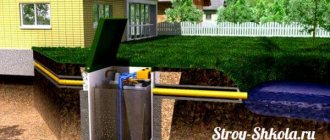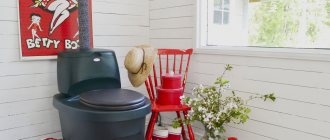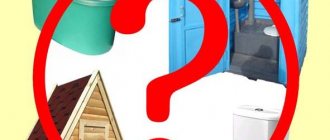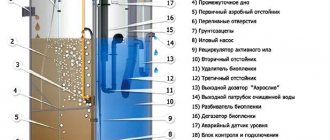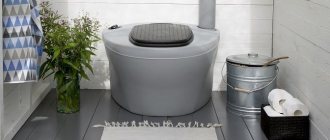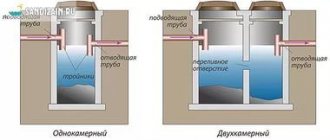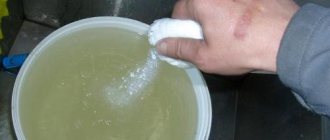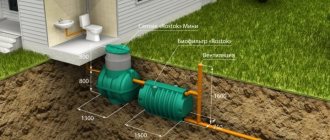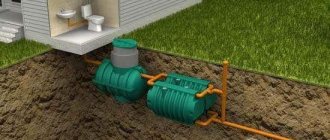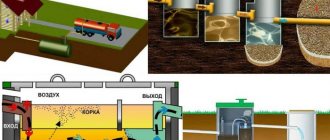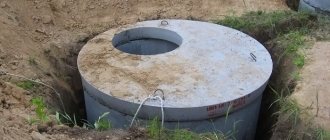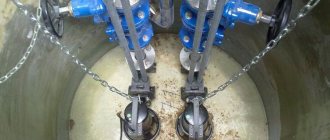Not only an important, but also a mandatory component of a comfortable stay is a trouble-free sewer system for a country house that does not require labor-intensive maintenance - what to choose as a structure for drains depends on many factors. The principle “the most expensive is the best” has long lost its relevance. The amount of investment must be justified by the extent to which the chosen model meets the requirements. The latter, in turn, are determined by operating conditions. Thus, before purchasing a ready-made model of a waste disposal unit or starting construction with your own hands, you should carefully calculate both the parameters of the sewer system, choose its type and develop a communications scheme.
The influence of high water on the functioning of an autonomous sewer system
At what depth the groundwater is located on the site, it is necessary to find out before designing the house sewer system and choosing a septic tank. This is one of the main factors that cannot be ignored. Otherwise, big troubles and large expenses are possible.
- A septic tank can “float” in the spring, being pushed out of the ground by the forces of frost heaving and the pressure of water, the level of which is at its highest at this time of year.
- Upon ascent, the entire sewer system receives serious damage and depressurization occurs.
Spring emergence of a septic tank Source rotoplast.ru
- Increasing the water level above the installation level of the tank can cause partial or complete flooding and, as a consequence, the release of sewage to the outside.
- The slightest leak is fraught with contamination of groundwater and the entry of waste into the fertile soil layer and sources of drinking water.
The slightest disruption to the normal operation of the sewer system in such problem areas means not only additional large costs for its reconstruction, but also a high risk of bacterial contamination of a large area of soil. Which will lead to a persistent unpleasant odor, intestinal infections and other problems.
Filtering fields: application features
The filtration field is a more complex engineering structure than the FC, which cannot be called compact, but it can also be used in areas with high groundwater level and a large volume of wastewater, more than a cubic meter per day. True, not every soil is suitable here; nevertheless, it must filter well. Most often, filtration fields are made in loamy soil.
The filtration field is a system of perforated pipes with a diameter of 110 mm (you can take ordinary plastic sewer pipes and make cuts in them) at a depth of at least half a meter with a slight slope.
How to create a proper filter field:
- make a cushion of crushed stone and gravel with a height of 0.2 m;
- lay pipes;
- cover again with crushed stone and gravel, the height of the layer is 10 cm above the top of the pipes;
- cover with a geomembrane;
- cover with soil.
To correctly calculate the number and length of pipes in such a sewerage scheme for a private house, you need to take into account two parameters: the volume of wastewater and the filtering properties of the soil. Pipes can be positioned in different ways, but the more branched and longer the pipeline, the better the cleaning will be.
There is a simple table that allows you to make an approximate calculation of the filtering field. It is easy to use: the top line shows the volume of the septic tank, and the type of soil in the left column. If the type of soil on the site is sandy loam, the volume of the septic tank is 5 cubic meters, then at least 5 meters of pipes are needed.
For constructing a filtration field for a household septic tank, such a table is quite sufficient.
The downside of the filtration field is that it always “bites off” a significant piece of the area, at least 30 square meters. And the biggest advantage of using this system, besides the high quality of cleaning, is durability; the filtration field silts up after approximately 10 years of service.
Definition of groundwater level
Water in the soil is never at one constant level - it changes depending on the time of year and the amount of precipitation. These seasonal fluctuations lead to the fact that in the spring, during the period of snow melting and flooding, groundwater comes closest to the surface of the earth, and during summer drought and winter frosts it drops lower. Therefore, it is necessary to determine the level at certain moments.
Graph of groundwater level changes by month in different years depending on weather conditions Source konspekta.net
When deciding which septic tank to choose for a private house with high groundwater, the groundwater level is measured at the peak of the rise. If you need to equip a cottage with seasonal residence only during the warm summer months, it is enough to take into account the maximum level for this period.
As a rule, the depth of the aquifer is determined at the stage of designing or laying the foundation of a house. But if you decide to modernize an old dacha or a purchased house without communications, you will have to do it yourself.
To do this, a well is drilled at a site more than 2 meters deep, and in the “high” season, using an ordinary rope with a weight, they measure how far the water is from the surface. The level is considered high if this distance is less than 1.8-2 m.
It happens that no measurements are required - in some areas groundwater appears on the surface of the earth in the spring. In such situations, it is necessary to install a drainage system, since on swampy soil it will be difficult not only to improve the house, but also to grow vegetables and fruit trees.
Area with high groundwater level Source kamskoe-ustie.ru
Sewerage Unilos-Astra
Unilos Astra - stations that provide real comfort to their users and have achieved almost 100% cleaning level. Are being produced. They combine two types of cleaning - mechanical and biological. Designed for long-term operation. They undergo a very thorough inspection before sale. Autonomous sewage system Unilos is well adapted for operation in Russian conditions. They have good reviews from users who have already purchased them.
Also a very good indicator of the strength of the case is the walls and partitions made of polypropylene, with a minimum thickness of 20 mm. Among the design features is the ability to be equipped with a post-treatment unit and a built-in sewage pumping station (SPS). Thanks to this, the output is the purest process water possible.
The stations are represented by a wide range of models. Depending on the modification, they vary depending on the pipeline length and burial depth. Insulated models are produced for cold climate zones.
Prices for stations from this manufacturer start from 62,000 rubles.
Advantages
- Deep biological wastewater treatment - 98%;
- Sealed housing that does not allow unpleasant odors to pass through;
- Silent operation of the station;
- Automatic operation of the station, which does not require constant monitoring;
- Durable, water-permeable body, no corrosion;
- Durability and reliability - service life of 50 years.
Popular models Unilos Astra
Autonomous sewage system Astra 3
- Number of users 3
- Productivity 0.6 m3/day
- Salvo release 150 l
- Inset depth 45 - 60 cm
Price: 68 000
R.
–15%
Autonomous sewage system Astra 5
- Number of users 5
- Capacity 1 m3/day
- Salvo release 250 l
- Inset depth 45 - 85 cm
Price: 84 150
R.
–15%
Autonomous sewage system Astra 8
- Number of users 8
- Capacity 1.6 m3/day
- Salvo release 350 l
- Inset depth 45 - 85 cm
Price: 101 150
R.
–15%
Autonomous sewage system Astra 10
- Number of users 10
- Capacity 2 m3/day
- Salvo release 550 l
- Inset depth 45 - 85 cm
Price: 135 575
R.
–15%
Choosing a septic tank
It is impossible to say for sure which septic tank is better if the groundwater level is high. To do this, you need to know the expected operating conditions:
- seasonal or permanent use;
- volume of wastewater for a certain period of time;
- type of soil, its filtering properties and degree of frost heaving;
- relief of the site;
- the presence of reservoirs and artificial sources of drinking water nearby.
In any case, the drainage container must be airtight and have very strong walls to withstand the backwater of water and soil pressure without deforming or collapsing.
By design, a septic tank can be a simple storage tank, a system of overflow tanks, or a factory-made deep cleaning station.
Drives
The simplest, most reliable and budget option for a summer cottage is a septic tank. It is also suitable for houses with a small number of residents and a minimum set of water-consuming equipment.
A storage tank is a large-volume sealed container for collecting wastewater, which, when filled, is emptied by sewage disposal equipment.
Septic tank - installation diagram Source polik.kz
This option has many advantages:
- low cost;
- ease of maintenance;
- possibility of operation at very high groundwater level;
- compliance with sanitary standards;
- autonomy, independence from power sources.
Note! Typically, wastewater enters the storage tank by gravity without pumping. The need for them arises only when the container cannot be installed below the point where the sewage system exits the house.
The disadvantages include the need to frequently pump out the container, the availability of always free access roads to it, and the expense of calling a sewer truck.
Drives can be homemade or factory-made. The first ones are constructed from monolithic concrete or welded metal containers. Factory septic tanks are made from steel and polymer materials. To give strength and rigidity, plastic containers are made with ribbed walls. Their main advantage over homemade ones is absolute tightness, including the entry points of sewer and ventilation pipes.
One of the models of a factory sewage storage tank Source prom.st
Advice! If the groundwater level is very high and the soil is clayey, preference should be given to horizontal septic tanks made of fiberglass or polypropylene - these materials have sufficient strength and maintain integrity when the soil moves under the influence of frost heaving. And the horizontal arrangement allows you to reduce the installation depth without losing storage capacity.
Biological treatment stations
Before choosing a septic tank for a private house with high groundwater, you need to evaluate the possibility of placing large-scale structures on the site. If the volume of wastewater is large, but there is little space and there is nowhere to discharge untreated water, then the best solution would be to install compact stations for deep biological treatment of sewage wastewater (GBTP). These are sealed containers, divided into several compartments, in each of which stage-by-stage purification occurs and the output is practically pure industrial water, which can be used for irrigation, washing paths and facades, and other technical needs.
One of the designs of SGBO Source kolodes-kopka.ru
See also: Catalog of companies that specialize in the design and installation of sewerage and water supply
The number of cameras in the station and the degree of cleaning vary.
- A receiving compartment is available in all stations; mechanical separation of wastewater into solid particles, greasy films and clarified liquid occurs in it.
- The clarified liquid flows by gravity into the next chamber.
- This may be a forced air aeration chamber in which biological decay processes occur with the participation of enzymes and aerobic bacteria.
- Some gas storage facilities have sealed compartments with anaerobic bacteria that process waste without oxygen.
- The last to be placed are settling tanks, in which the purified water is finally clarified and discharged onto the terrain, and the solid fractions that settle down are pumped back to the receiving compartment.
Such installations are equipped with equipment powered by electricity - compressors, pumps, air lifts, automatic valves. Energy dependence and high cost of both the station itself and its installation and maintenance are their main disadvantages. But they are completely offset by reliability and ease of use, and a high degree of wastewater treatment. What is important for permanent residence households.
5-chamber septic tank for a residential building Source frear.ru
Pumping out unprocessed silt deposits from such septic tanks is required much less frequently than from conventional storage tanks. Moreover, they can be used to prepare compost for fertilizing garden plantings. And large volumes of technical water allow you to save on irrigation.
Overflow tanks with filtration structures
When groundwater is deep, there are no problems with wastewater treatment. It is enough to install 2 or 3 storage tanks in series (or one large one, divided into compartments). The settled liquid from the first compartment, upon reaching a certain level, flows by gravity into the second, where it is subsequently clarified, and then into a drainage well without a bottom, installed on a filter base - a thick layer of crushed stone or gravel.
This option does not work at high groundwater levels, since groundwater itself will seep into the last unsealed well, overflowing it. Therefore, instead of it, special filtration structures are built, into which clarified wastewater is pumped by a drainage pump. Or, if the terrain and groundwater allow, they pour out by gravity.
Two-chamber overflow septic tank with drainage tunnel Source bitrix-cdn.ru
Often you have to decide when choosing similar septic tanks for high groundwater: which is better - a plastic factory one or one built from reinforced concrete rings. Everything has already been said above about the advantages of factory-made products, but concrete ones also have their own advantages.
- They are cheaper.
- They have high strength and large mass, which prevents floating.
Biological treatment station (BTP)
Other names are aeration septic tank, autonomous sewerage system or local treatment plant. The wastewater treatment at the station occurs with the help of aerobic and anaerobic bacteria. Aerobic bacteria require oxygen to function, so the stations provide aeration (saturation of the drain with oxygen).
Microorganisms break down complex substances in the drain into simpler ones. As a result, gas, silt and water are formed. The gas exits through the ventilation, the sludge remains in the septic tank, and clean water is discharged by gravity through the outlet pipe or by a pump. The degree of wastewater purification in an autonomous sewer system is high - 98%, so additional treatment is not required. The water coming out of the sewer is clean, transparent, and odorless. Can be used to water non-bearing plants or discharged into a pond/drainage ditch.
The biological treatment station is energy dependent. It operates from a compressor or compressors, which are usually installed inside the device in a separate compartment. Compressors supply compressed air to pumps that pump wastewater from chamber to chamber, and to aeration elements that saturate the drainage with oxygen.
An aeration septic tank has three to six chambers. The most popular option on the Russian market is an autonomous sewerage system, designed according to the design of engineer Jan Topol. It has four cameras:
- Reception chamber.
- Aerator.
- Secondary settling tank.
- Sludge stabilizer.
The receiving chamber in this system acts as an averager. In it, the runoff is equalized in temperature and chemical composition. Thanks to this, the septic tank works perfectly even if the wastewater does not flow into it regularly.
The main process of wastewater treatment takes place in the aeration tank: the water is saturated with oxygen, bacteria multiply and eat all organic matter.
From the aeration tank, the runoff enters a secondary settling tank, in which the water is separated from the sludge and leaves the station.
In the sludge stabilizer, activated sludge is separated from waste sludge. The activated sludge goes back into the receiving chamber, and the waste sludge remains at the bottom of the stabilizer.
Why did this particular autonomous sewage system gain popularity?
- There is no need to call a sewer for service.
- Thanks to the presence of an averaging chamber, the station can continue to operate even if no waste flows into the septic tank for some time. This allows the station to be used in dachas where owners do not come regularly.
| Advantages of aeration autonomous sewerage | Disadvantages of aeration autonomous sewerage |
| Deep water purification, about 98% | Volatile |
| Takes up little space on the site | The price for the device itself is higher than the price for a septic tank* |
| Doesn't smell | Requires preservation during long periods of inactivity |
| Suitable for any site with any ground conditions | Requires maintenance once every 6-12 months |
| Does not require a vacuum cleaner for maintenance | |
| Does not require anchoring and sprinkling of the central fiber structure |
*If you need an autonomous sewer system for a house or cottage where a family of five or more lives, then an aeration septic tank with turnkey installation will cost you less than a septic tank with post-treatment.
Video description
An option for constructing a concrete structure is shown in this video:
But such drives are difficult to make hermetically sealed. No matter how carefully the seams between the rings are sealed, over time, due to soil movements and the aggressive effects of runoff, the sealants are destroyed. And concrete itself cannot be considered completely waterproof. Therefore, reinforced concrete rings are not recommended for use if the water lies above the level of 1.3-1.5 m.
Advice! To increase the degree of wastewater treatment, special agents with live bacteria are periodically added to the second and third containers to quickly biologically break down sewage and eliminate unpleasant odors.
Means for septic tanks in the form of gel and powder Source allegroimg.com
Like SGBO, overflow structures are energy-dependent, but they consume much less energy, since only pumps work in them, and they are turned on periodically.
How to choose a manufacturer of autonomous sewerage for a private home
There are many septic tank manufacturers represented on the Russian autonomous sewerage market. They differ in operating principle, price, warranty conditions, and so on. To make it easier for you to understand, we have written for you an article “Rating of the best septic tanks for a country house.” This included both septic tanks and biological treatment stations with different structures and operating principles. The rating is based on our seven years of experience and feedback from our clients.
However, we have also identified for you several manufacturers that will suit certain conditions.
The best septic tank for a summer residence - Termite
The septic tank body is made of low-density polyethylene using rotational molding. It has the shape of a parallelepiped, because of this the soil presses unevenly on the walls of the body and there is a risk of deformation. Sprinkling the DSP during installation helps minimize this risk. The manufacturer does not provide any warranty for the septic tank. However, its price is quite low, so for an intermittent presence at the dacha, we recommend Termite.
The best septic tank for permanent residence - Rostock
It is made in the same way as Termit, but unlike it it has a cylindrical body. This increases the strength characteristics of the septic tank, so it does not require sprinkling of the central fiber foam during installation. Also, the Rostock septic tank has a special system of pipes and overflows inside, due to which the runoff from suspended matter is cleaned better than its competitors. Thanks to this, the post-treatment after the Rostok septic tank silts up less, but the cost of these settling tanks is higher.
The best autonomous sewage system for a summer residence - BioDeka
Due to the cylindrical shape of the body and only one machine seam, the BioDeka biological treatment station is very durable. Its body can withstand strong soil pressure and guarantees no leaks. BioDeka also has very simple and reliable electrics. The station is single-mode, so it has only one compressor and operates without a solenoid valve. BioDeca is chosen by summer residents because it:
- insensitive to voltage drops - has simpler and more reliable electrics compared to analogues;
- universal - it can be converted from gravity to forced and vice versa;
- has a long warranty on the body and electrics (5 years). This is very important if the station stands idle for six months.
The best autonomous sewage system for permanent residence - Eurolos
Eurolos also has a cylindrical body and lugs, which makes the station strong and stable. Instead of a compressor, it has an ejector and a pump with timer control. Because of this, the degree of wastewater purification is slightly lower than that of BioDeka, however, water from the septic tank can still be discharged onto the ground without additional treatment. Eurolos is installed for permanent use, since it does not require frequent maintenance (you will need to call a vacuum cleaner once a year) and is not afraid of non-degradable waste, including pet hair. In addition, the Eurolos septic tank does not have a homogenizing chamber, which makes it virtually unsuitable for use only during the season or for occasional use.
Types of additional filtration structures
When groundwater levels are high, conventional filtration fields are useless and even dangerous, since incompletely purified wastewater immediately mixes with soil liquid and is carried over a large area. Therefore, any filtration structures used for post-treatment must be raised above the groundwater level.
Such a filter is suitable if an overflow septic tank is chosen in a private house. Which is better for high groundwater depends on its level, the duration of the rise to the maximum level and the availability of free space on the site. This may be a drainage well, a tunnel or an embankment.
- Filter well.
It is built from reinforced concrete rings and installed at a distance of 2-2.5 meters from the septic tank. If groundwater reaches the surface of the earth during a seasonal rise, the well is placed on an embankment of filtering materials about 30 cm high. The same layer of drainage cushion is made when deepening the well, but its bottom in any case should be above the groundwater level.
Three-chamber septic tank with a filter well Source vanna.by
The well has no bottom, and cracks or holes are made in its walls to allow clarified waste to flow into a filter layer of crushed stone, with which the structure is filled up to half its height. Geotextiles are laid on the crushed stone, and then the well is insulated, making an embankment of soil to the very top. It is closed with a hatch with a ventilation riser leading outside.
- Drainage tunnel.
Drainage tunnels (infiltrators) are plastic trays with stiffening ribs and inlet holes at the ends for installation of supply pipes. They are installed on the filter pad with the open part down.
Sewerage Alta Bio
Alta Bio autonomous sewage systems are compact, safe and durable wastewater treatment plants, manufactured by Alta Group. Thanks to multi-stage purification, the output water is clear and has no unpleasant odor, and it can also be reused. The stations are not subject to corrosion, as they are made of polypropylene or polyethylene with a body thickness of 8 mm. The big advantage is that Alta Bio septic tanks do not require preservation for the winter; you just need to turn off the power supply.
Alta Bio septic tanks have different models that are designed for different numbers of people. Options for any type of soil are also presented. Alta Bio + models are designed for clay soils with high groundwater levels. Alta Bio models without markings are installed in sandy soil.
Prices for septic tanks start from 74,000 rubles. The stations are designed for long-term operation, since the service life of the Alta Bio autonomous sewage system is 50 years.
Advantages
- High level of wastewater purification - 98%, thanks to the passage of wastewater through three settling tanks;
- Non-volatility – if there is a power outage, Alta Bio will continue to work automatically;
- It is possible to enable additional UV cleaning;
- Household waste does not affect the operation of the Alta Bio station;
- The appearance of unpleasant odors is excluded;
- Service life – 60 years.
Popular Alta Bio models
Autonomous sewage system Alta Bio 3
- Number of users 3
- Productivity 0.6 m3/day
- Salvo release 120 l
Price: 78 500
R.
Autonomous sewage system Alta Bio 3 +
- Number of users 3
- Productivity 0.6 m3/day
- Salvo release 120 l
Price: 107 500
R.
Autonomous sewage system Alta Bio 5
- Number of users 5
- Capacity 1 m3/day
- Salvo discharge 210 l
Price: 101 175
R.
Autonomous sewage system Alta Bio 7
- Number of users 7
- Capacity 1.4 m3/day
- Salvo release 270 l
Price: 127 500
R.
Video description
This video shows the installation process of infiltrators:
But in the case of high groundwater, the pit for it is not torn off, but only the fertile layer is removed from the ground and the resulting trench is filled with rubble. The tunnel, installed and connected to the septic tank, is covered with geotextile and a high embankment of soil is made above it, through which a pipe is drawn for the flow of air, the presence of which is necessary for the breakdown of organic matter.
Note! The number and total volume of infiltrators depends on the volume of wastewater and soil permeability and is calculated individually.
- Filter embankment.
This structure is an analogue of filtration fields buried in the ground, which are installed when the groundwater level is low. But in this case, drainage dispersive pipes are placed in an embankment of crushed stone, and the contents of the septic tank enter them not by gravity, but by force, by pumping.
As in the case of the structures already described, the filter embankment is covered with geotextile to prevent siltation, insulated with a layer of soil and a ventilation pipe is removed. This structure works even in wetlands if the crushed stone layer is laid on an embankment about 1 m high.
How to choose an autonomous sewer system for a private house
The choice of an autonomous sewer system depends, first of all, on the number of residents, as well as the number and type of plumbing installed. However, there are two more important points that many of our clients do not know or forget:
- Method of draining clean water.
- Depth of the vent pipe.
Clean water drainage method
Filter soil and low groundwater. For such conditions, an autonomous sewer system with a septic tank and a filter well or a gravity biological treatment station are suitable.
From the septic tank, the effluent enters the filter well, is distributed over the load (crushed stone), is purified with the help of microorganisms living in the sludge, and is absorbed into the soil. Every 3-5 years, crushed stone needs to be changed, as the silt becomes more and more every year and it stops allowing water to pass through.
There is no pump installed in the gravity station; clean water comes out through the outlet pipe. Such an autonomous sewer system is most often installed in conjunction with a well. Since the water from the station comes out much cleaner than from a septic tank, the well silts up less often.
Fig.4. Autonomous sewerage system with filter well
Non-filtering soil and/or high groundwater. In this case, an autonomous sewer system with forced drainage is installed. Clean water is sent either to a drainage ditch or discharged into a reservoir.
Important! A pump for draining clean water for forced stations is provided to customers as a gift.
Fig.5. Autonomous sewage system with forced drainage of water into a ditch
Fan pipe depth
Depending on the depth of the sewer pipe, a modification of the autonomous sewer system is chosen. For most septic tanks, the inlet pipe is cut to a depth of 800 mm from the ground level, and since the supply pipe is installed with a slope, the depth of the drain pipe should be no less than 700 mm. If the pipe is dug deeper, then you need to either dig it up and lift it, or buy a septic tank with an extended neck.
For plastic septic tanks, the elongated neck is purchased separately and installed on the device during installation. Biological treatment stations are immediately produced in two or three factory modifications:
- With a standard neck.
- With an extended neck.
- Intermediate option, midi series (not available from all manufacturers).
An extended neck is an additional expense, so you need to find out in advance, before installation, whether you need it. A surveyor from , who will visit your site before drawing up an estimate, will help you with this.
Autonomous sewerage performance
Septic tank with post-treatment. The volume of the septic tank should be equal to three times the volume of daily wastewater, since for normal cleaning the drainage must settle for at least 3 days. There is approximately 200 liters of waste per person. Accordingly, if there are 3 people in the house, then the volume of the sump should be equal to:
200 liters*3 people*3 days = 1,800 liters or 1.8 m³
However, if the house has a minimum set of plumbing fixtures, then the volume of drainage per person may be below 200 liters per day, and then a septic tank can be taken with a smaller volume.
One filter well takes on average up to 500 liters of water per day. If a more productive septic tank is installed, it is recommended to install two wells.
Aeration autonomous sewerage. In stations, wastewater is not settled, but processed, so with a smaller volume, an aeration septic tank purifies the same amount of wastewater as a sump tank. To select a station based on performance, you do not need to know any formulas; the maximum number of users is indicated in the name of the autonomous sewer system - for example, BioDeka 5 or Astra 8 (where “5” and “8” are the number of users).
However, when choosing an autonomous sewer system, you must also take into account the volume of the volley discharge of the treatment device. If you have a bathtub installed in your house, then the volume of the salvo discharge should be at least 25% greater than the volume of the bathtub.
Installation Features
Having decided which septic tank is best for a private house with a high groundwater level in your case, you can proceed to design and installation. But first you need to choose a place to locate the treatment plant.
Selecting a location
When determining the location of the septic tank, take into account the following requirements:
- from it to any source of water, including the neighbor’s, there must be a distance of 25 m or more;
- It is better to keep the distance to the house minimal, but not less than 5 m;
The closer the septic tank is located to the outlet from the house, the higher the entry into it will be Source remontik.org
- to make the route as short as possible, the septic tank is placed against the wall of the house behind which the kitchen and bathroom are located;
- You should try to remove the pipe from the house as high as possible, burying it no more than 50 cm into the ground;
- if other buildings are planned on the site, it is necessary to provide for their connection to the septic tank and the possibility of access to it by a sewer truck;
- To eliminate the risk of flooding by melt and flood waters, the container should not be placed in lowlands.
What to consider during installation
When digging a pit for a septic tank, groundwater may flow into it, so before starting work you need to acquire a drainage pump to pump it out. And wooden shields to strengthen crumbling slopes. The pit must be significantly larger than the size of the tank in plan, so that there is enough space for the installation of anti-heaving backfill.
With a high groundwater level, it is better to install horizontal septic tanks and make the pipe entry as high as possible. But at the same time, you cannot reduce the optimal slope of the drain pipe coming from the house.
Optimal septic tank installation scheme Source septobak.ru
Criterias of choice
To drain drainage fluid from the house, a small stationary model is installed. Its power should be comparable to the number of points of water use - bathroom, toilet, washing machine or dishwasher, sinks, swimming pool or sauna. Select according to the parameters of power and volume of the storage tank. It is better if the pump station is equipped with two pumps.
To operate the sewer system of a multi-story building, you will need a large storage tank and several units that will pump out the liquid. An important point is the presence of a cutting mechanism. It is better when there is one, since debris and large waste can clog the outlet pipe.
Video description
Features of installing and anchoring septic tanks in wetlands is the topic of the following video:
The most common mistake when installing septic tanks is failure to follow the rules for backfilling. It is carried out only after the installation of the entire system has been completed and it has been checked for leaks. In addition, you can only fill a septic tank that is completely filled with water.
- Firstly, this is necessary for the final shrinkage of the structure under its own weight.
- And secondly, if the container is left empty, its body may become deformed due to the pressure of the filling material on it.
Failure to comply with this requirement often leads to depressurization of pipe connections and inlet pipes.
The drain pipe from the house is laid in a trench, the bottom of which is covered with sand. Before equipping the entrance to the septic tank, check its slope, which should be 2-3 degrees. Changing it in any direction changes the flow rate of the wastewater, which is why solid inclusions can linger in the pipe and form blockages.
It is very important to maintain the slope of the sewer line Source aquaterem.com
Backfilling of pipes is also first carried out with sand or small crushed stone in order to prevent pressure on them from the soil, which increases in volume when it freezes.
Infiltrators and drainage tunnels
In small areas, the installation of filtration fields is impossible, and the optimal solution here may be the use of ready-made infiltration or drainage tunnels.
They are installed one or two meters from the septic tank, and one such device with a volume of 300 liters replaces about 36 meters of drainage pipes and 800 kg of crushed stone. Externally, the ecnhjqcndj looks like a large container without a bottom; in some models the walls are perforated, in others they are solid (but then a perforated drainage pipe is built into the design).
Miket78FORUMHOUSE Member
Infiltrators form a cavity located underground into which water flows after the septic tank. The water goes into the ground - the cavity is freed. To ensure the required performance, it is not the number of septic tanks that is important, but the absorbency of the soil.
Individual modules of drainage tunnels can be easily assembled with each other into a structure of the required volume. They are installed in the same way as filtration fields, deepened at least half a meter from the surface of the earth, but covered on all sides and on top with a layer of sand or soil at least 50 cm thick.
Popular septic tank models
If a storage tank or overflow tanks are selected for the collection and disposal of household waste, the main criteria for their selection should be strength and tightness, as well as the volume required for your family. Such containers are produced by many domestic manufacturers; in each line you can find a model that meets your requirements. Among the most popular:
- storage septic tanks Astra from the company Unilos;
- three-chamber storage septic tanks Bars;
- Eurobion septic tanks from the NEP company;
- Topol drives with 2 or 3 compartments.
Eco-Grand septic tanks from the Topol company Source bitrix-cdn.ru
Otherwise, you should approach the problem of what is the best septic tank to install if groundwater is close and there is no space for additional filter structures. In such cases, deep wastewater treatment stations with a high degree of purification, which is 90-98%, are chosen.
The most reliable and effective of them, judging by consumer reviews, are equipment from the following brands:
- Tver;
- Leader;
- Topas;
- Tank;
- Unilos;
- Leopard.
Mounted SGBO Tver Source kolodes-kopka.ru
Installation features
You can install and connect household water pumping stations following the instructions. These are “sololifts”, which are placed near plumbing fixtures. They are compact and do not require special skills. The instructions indicate step by step the actions that need to be performed.
Another thing is to install a sewer station for a country house. For these works it is better to invite professional craftsmen. Accuracy and correct selection of components, as well as their final configuration, are important here. The sequence of actions is also important. A person who does not have experience and does not understand the nuances of devices will not be able to carry out installation correctly and will lose the manufacturer’s warranty.
Briefly about the main thing
Groundwater lying close to the surface creates many problems when installing an autonomous sewer system. But they are completely solvable with the right choice of septic tank. For a small dacha with seasonal living, the best choice would be a storage tank that is pumped out 1-2 times per season. For a private home equipped with a full set of sanitary and household appliances, a deep biological treatment station is more suitable, from which practically pure water can be thrown onto the terrain or used for technical needs. If the area of the site allows, you can save money and install overflow tanks with additional drainage structures instead of an expensive station.
Ratings 0
Why choose Eurolos?
Autonomous sewage systems Eurolos are an effective and efficient solution for any private home, from a small summer cottage for seasonal residence to an impressive-sized cottage and country hotel.
Decent level of cleaning
BIO stations and Eurolos PRO aeration units purify wastewater up to 95-98%, which makes it possible to environmentally and safely discharge the resulting water directly into the soil without the use of facilities for additional post-treatment of wastewater with soil.
Easy maintenance
It is enough to clean the contents of Eurolos septic tanks from harmless sludge once every two years. And AU Eurolos Pro does not even need additional loading with bacteria - it is enough to do this once at system startup.
High strength and reliability
A durable sealed design is ensured by manufacturing the station body from sheet polypropylene using automatic equipment. Polypropylene is resistant to both physical and chemical influences. The guaranteed shelf life of the Eurolos septic tank body is 50 years - a sufficient figure to install a septic tank once and forget about it.
Each of our septic tanks for a private home is an autonomous sewer system that shows excellent performance in any conditions.
Buy a septic tank for permanent residents “Topas”
Septic tanks "Topas": wastewater treatment at no additional cost. Are you choosing a reliable, durable and economical septic tank for your home? Pay attention to Topas septic tanks, the price of which is determined by the technical parameters and the complete set of treatment devices.
They allow you to create conditions in your dacha or country house that are comparable in comfort to living in a city apartment. We offer to buy Topas septic tanks, which effectively clean household wastewater and perform their functions without regular pumping. Thanks to the variety of models, you can choose an option with the desired performance for permanent or seasonal use.
Requirements for septic tanks in a suburban area
According to SNiP and SaniP there are clearly defined standards. The treatment facility should be located at a distance:
- At least 10 m from a residential building or other structures.
- At least 1.5 m from the border of the site (it is called a boundary or a ditch).
- No closer than 20 m from the well (and the wells of neighbors must also be taken into account).
- At least 25 m from water pipes.
- No closer than 5 m to the gas pipeline.
If we are talking about a small summer cottage plot of 6 acres, then it is very difficult to fulfill such requirements. But if you violate them and your neighbors complain about you, then such amateur activity will result in a fine.
Also, when choosing a system, you need to consider its performance. The minimum septic tank indicators should be 1 m3 per day, based on the assumption that a family of 3-4 people uses the sewerage system.
In addition, you need to calculate the volume of the treatment plant. Again, based on the number of residents. If we take into account that all household members use showers, sinks and toilets, then on average about 200 liters are consumed per person per day. Accordingly, to understand how much volume a septic tank will require, you need to multiply the number of residents (let’s say 3) by the average water consumption (0.2) and multiply all this by another three. We get 3x0.2x3=1.8 m3.
The best option is a septic tank made of concrete rings or plastic, or a biological treatment station. What to choose?
Main types of autonomous sewers
Autonomous home sewerage is not a luxury today. After all, a comfortable existence in the house implies the presence of a toilet, bath and sink in the kitchen.
There are several ways to arrange drainage in a private house with your own hands. One of the easiest and cheapest is a cesspool, but this model is considered outdated.
Currently, there are more modern types of autonomous sewers; they use advanced technologies - a reservoir with one or several sections into which waste liquid is discharged, where it settles and is cleaned.
The simplest sewers
In this case we are talking about ordinary cesspools. They were popular more than 20 years ago and were used not only in dachas, but also for arranging the sewer system of houses in which people lived permanently.
This is the most primitive design, which is an ordinary pit covered with a wooden booth. Actually, this is an ordinary country toilet, into which dirty water after washing dishes and other waste were additionally drained. Everyone knows about the disadvantages of such structures. Firstly, complete unsanitary conditions, and secondly, an unpleasant smell. I also had to empty such a pit myself, and this is not the most pleasant task.
Later, modern dry toilets appeared, which can be installed both on the street and in the house. But to operate them you need to use very toxic drugs. The container must be constantly cleaned, and since the waste is impregnated with chemically aggressive substances, there is also the problem of their disposal.
Therefore, the best option is a plastic septic tank, a deep biological treatment station or a septic tank made of concrete rings. Before figuring out what to choose, let's consider the standard requirements for organizing such systems.
cesspool
Constructing a cesspool is the simplest way to make an autonomous drain in your home with your own hands.
Device
The design is simple - it is a sealed container dug into the ground on the territory of a private house. All wastewater is drained into this container through the collector. The pipeline is laid in a layer of soil that is not subject to freezing, otherwise the pipeline will need to be insulated.
Household waste storage facilities are equipped in accordance with the following standards:
- The distance from them to the water main is at least 10 meters, to the well - 20 m, to the boundaries of the site - 1 meter.
- The depth of the hole depends on the passage of groundwater, but a maximum of 3 m.
- Location from buildings, at a distance of at least 10 m, otherwise there is a risk of undermining the foundation.
Drives are often made from:
- brick - only the ceramic type is suitable, since it is able to withstand aggressive environments, the container is made of a round shape;
- reinforced concrete rings - their use allows you to make a durable structure, but installation requires construction equipment;
- plastic containers - only those with thick walls that can withstand exposure to chemicals are suitable;
- concrete monolithic structure - constructed on site from cement-concrete composition and reinforcement.
Operating principle and maintenance
The system operates as follows: all sewage water flows through the main pipes into a container. The accumulated wastewater is pumped out using sewage disposal equipment. This should be done as the tank is filled, but always every six months. And once every six months it is necessary to carry out disinfection with special compounds.
According to the standards, wastewater should not reach 0.35 cm to the surface of the container. Since, when the tank is overfilled, liquid leakage may occur, resulting in contamination of the soil and its aquifers.
Advantages and disadvantages
The advantages of cesspools located in areas adjacent to a private house include:
- The storage tank is sealed, which prevents soil contamination;
- Ease of installation - the ability to build a structure with your own hands;
- Low construction costs;
- Energy independence of the system.
Flaws:
- need for periodic cleaning;
- the model is only suitable for houses with temporary residence and a small number of residents, since with a wastewater volume of 1 cubic meter, even large containers will fill quickly and will need to be cleaned several times a week, and this is not cheap;
- the presence of foul odors during drainage;
- the need for free space for access for vacuum cleaners;
- It is not possible to develop it with nearby groundwater flowing.
Do-it-yourself autonomous sewage system
Before you begin installing an autonomous sewer system in a private house with your own hands, you should read the manufacturer’s instructions for its construction. The installation of a septic tank with a biofilter must be done in stages.
Design and volume calculation
The trouble-free operation of the sewer system in a private home depends on the correctness of the calculations and a well-done project.
When designing, one should take into account the daily volume of wastewater, the topography, the location of groundwater, the number of drain points, the placement of objects on the territory (houses, fruit plants, water sources, etc.).
The project should include, in addition to the septic tank:
- external communications and treatment facilities;
- internal pipes and devices;
- ventilation system.
Sanitary standards
The principle of construction and operation of septic tanks and biotreatment stations is prescribed in regulations; they develop standards for the placement of treatment facilities, protective standards for surface water and environmental safety (SNiP No. 2.04.03-85, No. 2.04.04-84, No. 2.04.01 -85; SP 32.13330.2012; SanPiN 2.1.5.980-00 and 2.2.1/2.1.1.1200-03).
New standards developed in 2021 are reflected in STO NOSTROY 2.17.176-2015. Today, this is the main standard regulating the rules for the design and construction of autonomous sewage systems.
Standard norms for location from sewerage:
- at home - 5 meters;
- water intake (well, borehole) - 20 m, if there is no soil with high filtering capacity between the aquifer and the filtration field, and from 50 to 80 meters, if there is sandy or clayey soil;
- roads – 5 m;
- site boundaries – 4 m;
- trees – 3 m (up to bushes 1 meter);
- other bodies of water (streams, rivers) – 10 m;
- reservoirs with standing water (lakes, ponds) – 30 m;
- underground gas pipeline – 5 m.
Internal equipment
For internal sewerage, PVC or polypropylene pipelines are used. You need to choose taking into account the water temperature and the resistance of the material to household chemicals.
The size of the products should be selected based on the number of gutters. For a sink - 50 mm, for a toilet - 110 mm. The degree of slope of the pipes is affected by their size: 50 mm - 3 cm per meter, 110 mm - 2 cm.
To prevent the flow of waste in the opposite direction, a check valve is installed. To prevent the smell from entering the room, siphons are installed.
When installing a structure with your own hands, you need to pay special attention to the junction of the internal and external mains - the outlet from the house:
- when installing a sewer system in a finished house, the outlet can pass above the ground, but it requires insulation;
- through the foundation is the best option;
- through the wall, the pipe must pass in a sleeve - a larger pipe.
Ventilation of the sewer system
Ventilation is an important part in the sewer system. It helps to normalize the pressure in the main line, which changes when the wastewater is drained, and ensures the removal of accumulated gas. In addition, it extends the life of the equipment.
Classic ventilation is a vent pipe, the free end of which is led to the roof. It rises above the chimney and house ventilation pipes, and is located at least 4 meters from the windows. The optimal diameter of the fan pipe is considered to be 110 mm.
Installation of external communications
External communications are the main pipeline from the house to the place where wastewater accumulates. Ideally, a straight pipe with a slope towards the tank of 2 - 5 degrees.
It is permissible to cut into the drainage line, for drains from a bathhouse, etc. But all these places increase the risk of congestion, as the flow speed changes, so you must adhere to a number of rules:
- to avoid sudden changes in the direction of the drains, oblique crosses or pipes with an angle of 15, 30, 45 degrees should be installed;
- All tie-in areas should be equipped with additional inspection wells.
For external communications, plastic pipes or cast iron are recommended. They are placed in trenches at a depth not subject to freezing, otherwise they must be insulated.
Trenches 40 cm wide are dug, this is enough even for laying insulation. The depth is affected by the length of the pipeline and the location of its exit from the house. Each meter of the trench should have a slope of 2 cm.
